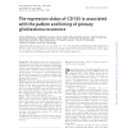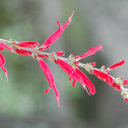[A case of peripheral-type primitive neuroectodermal tumor arising in the dura mater at the frontal base].
Raktažodžiai
Santrauka
A 7-year-old boy was admitted to our hospital because of headache and frequent vomiting. The patient was noted to have papilloedema and mild palsy of the right abducent nerve. Magnetic resonance image (MRI) revealed a large tumor in the frontal base with tumoral hemorrhage. Angiography showed the tumor was fed by anterior meningeal arteries. At surgery, the tumor was arising in the dura mater at the frontal base, and was removed totally. Histological examination showed the tumor to be composed of small cells with uniform round nuclei and minimal cytoplasm. Immunohistochemical studies were positive for MIC-2, NSE, C-KIT, vimentin, Class III-beta tublin and glycogen, but negative for NFP, synaptophysin, chromogranin A and GFAP. MIB-1 labeling index was 40-50%. The tumor was histologically confirmed to be peripheral-type primitive neuroectodermal tumor(pPNET). Following surgery, he underwent whole brain, whole spine and local radiation therapy(30 Gy in total respectively) and received two 5-day cycles of chemotherapy, consisting of intravenous administration of cisplatin 20 mg/m2/day, etoposide 60 mg/m2/day and IFOS 900 mg/m2/day. After these therapies, follow-up radiological examination showed there was no recurrence of the tumor for 24 months. Intracranial pPNET is rare. Ewing sarcoma and pPNET(ES/pPNET) is the designation given to a family of small round cell tumor arising in bone or soft tissues. Intracranial PNETs are devided into central nervous system PNET(cPNET) and pPNET. It is necessary that intracranial PNETs are divided into two types of PNETs because of different prognosis between these tumors. MIC-2 is a specific marker for pPNET/ES family and is useful in the differential diagnosis of these two types of tumors.




